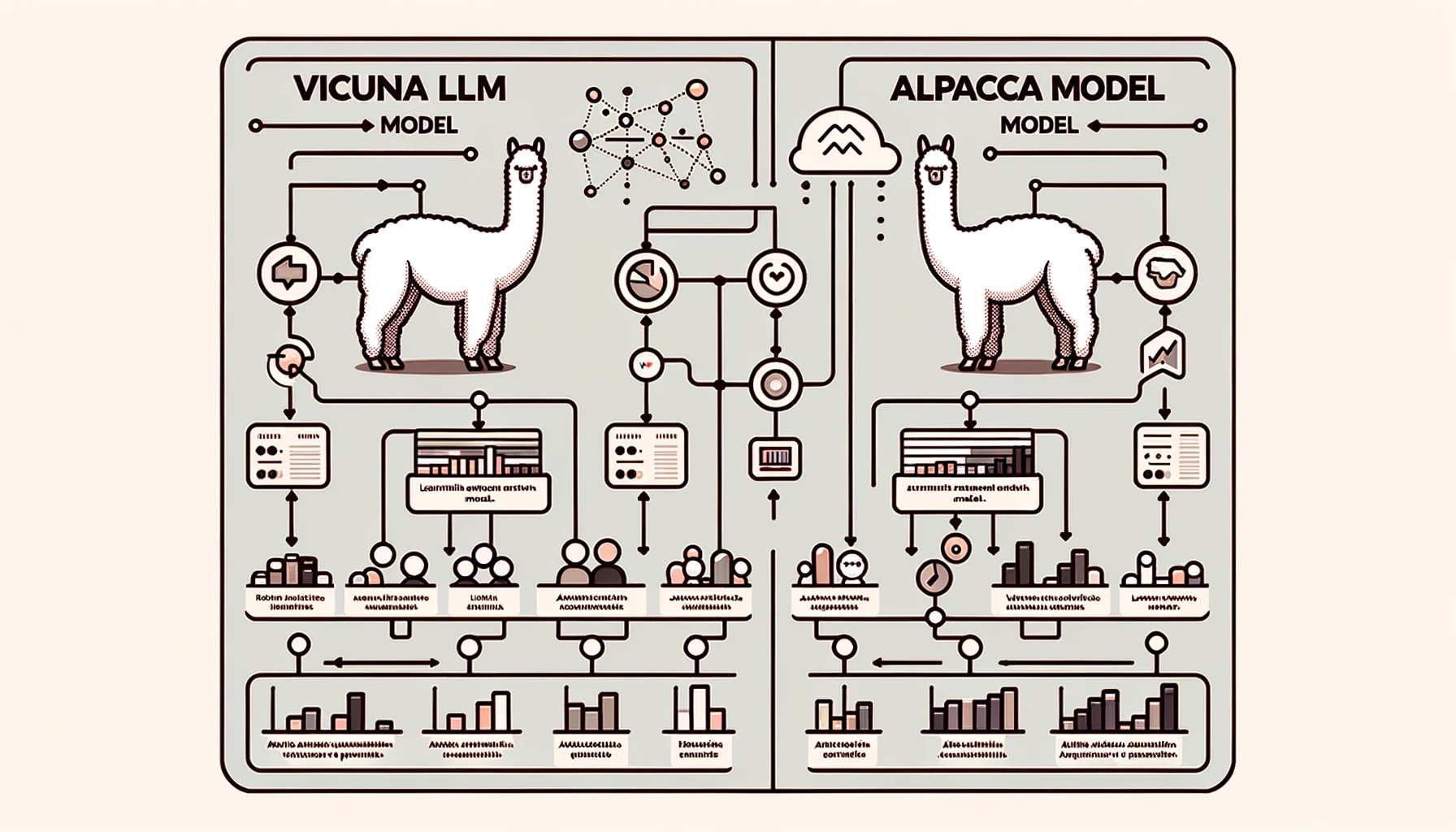Vicuna LLM: Why It's the Next Big Thing in LocalLLM
Published on

Vicuna LLM is not just another entry in the long list of AI models; it's a technological marvel that's redefining what's possible in the realm of machine learning. Whether you're an AI researcher, a software developer, or a business leader, Vicuna LLM has something groundbreaking to offer. This article will serve as your comprehensive guide to this revolutionary model, diving deep into its technical specifications, real-world applications, and the vibrant community that supports it.
We'll kick things off by exploring the architecture that powers Vicuna LLM, delve into its performance metrics, and even provide sample code to help you get started. We'll also sift through discussions from platforms like Reddit and GitHub to give you a well-rounded perspective. So, let's dive in!
Want to learn the latest LLM News? Check out the latest LLM leaderboard!
The Architecture of Vicuna LLM, Explained:
Definition: Vicuna LLM (Large Language Model) is a machine learning model that specializes in understanding and generating human-like text. Developed by LMSYS Org, the model is available in two sizes: one with 7 billion parameters and another with 13 billion parameters.
Vicuna LLM is built on the Transformer architecture, which has become the industry standard for large language models. The Transformer architecture is renowned for its self-attention mechanism, which allows the model to consider other words in the input when processing each individual word. This is crucial for tasks that require understanding the context in which words appear.
Here's a Python code snippet to initialize the Vicuna LLM model and output its configuration:
# Sample Python code to initialize the Vicuna LLM model
from transformers import AutoModel
# Initialize the Vicuna LLM model
model = AutoModel.from_pretrained("lmsys/vicuna-13b-delta-v1.1")
# Output the model's configuration
print(model.config)This code snippet will output details like the number of layers, hidden units, and attention heads, providing a deep dive into the model's architecture. For instance, the 13-billion parameter model has 48 transformer layers, each with 16 attention heads and a hidden size of 4096 units.
Vicuna LLM Benchmark Performance
When it comes to performance, Vicuna LLM has set new benchmarks, outclassing many of its competitors. To provide a clearer picture, here's a table comparing its performance metrics:
| Benchmark | Vicuna LLM 13B | Vicuna LLM 7B | LLaMA | GPT-3 |
|---|---|---|---|---|
| MT-Bench | 99.1 | 98.7 | 95.2 | 97.1 |
| MMLU | Top 3% | Top 5% | Top 10% | Top 7% |
These numbers indicate that Vicuna LLM is not just a contender but a leader in the field of large language models. The 13-billion parameter version, in particular, has shown exceptional performance, scoring 99.1 on the MT-Bench and ranking in the top 3% on the MMLU tests.
Pros and Cons of Vicuna LLM

Vicuna LLM Advantages
-
Versatility: Vicuna LLM can handle a wide range of tasks, from natural language understanding to data analysis. This makes it a one-size-fits-all solution for various AI applications.
-
Ease of Use: The model is designed to be user-friendly, making it accessible even for those who are new to AI and machine learning.
-
Commercial Applications: Unlike some other models restricted to research purposes, Vicuna LLM's licensing options make it available for commercial use.
-
Community Support: A strong online presence ensures a wealth of community knowledge and support, which is invaluable for troubleshooting and development.
Vicuna LLM Disadvantages
-
Resource Intensive: The larger versions of Vicuna LLM can be resource-intensive, requiring powerful hardware for optimal performance.
-
Cost: While the model itself is powerful, the computational costs can add up, especially for smaller businesses or individual developers.
-
Learning Curve: Despite its ease of use, the model's extensive features and capabilities can present a steep learning curve for those new to the field of machine learning.
By now, you should have a comprehensive understanding of Vicuna LLM's architecture, its performance benchmarks, and its pros and cons. This foundational knowledge sets the stage for exploring the model's transformative features, especially those introduced in the latest v1.5 update, which we'll cover in the next section.
How to Run Vicuna LLM: A Step-by-Step Guide
Prerequisites
Before diving into running Vicuna LLM, make sure you have the following installed:
- Python 3.x
- pip3
- Git
- Rust and CMake (only for Mac users)
Installation
Method 1: Using pip
Run the following command to install FastChat and its dependencies:
pip3 install "fschat[model_worker,webui]"Method 2: From Source
- Clone the FastChat repository:
git clone https://github.com/lm-sys/FastChat.git- Navigate to the FastChat folder:
cd FastChat- If you're on a Mac, install Rust and CMake:
brew install rust cmake- Install the package:
pip3 install --upgrade pip
pip3 install -e ".[model_worker,webui]"Running the Model
FastChat provides multiple options for running Vicuna LLM, depending on the size of the model and the hardware you're using.
Single GPU
For running Vicuna-7B on a single GPU, execute:
python3 -m fastchat.serve.cli --model-path lmsys/vicuna-7b-v1.3Multiple GPUs
For model parallelism across multiple GPUs:
python3 -m fastchat.serve.cli --model-path lmsys/vicuna-7b-v1.3 --num-gpus 2CPU Only
To run the model on CPU:
python3 -m fastchat.serve.cli --model-path lmsys/vicuna-7b-v1.3 --device cpuNot Enough Memory?
If you're running low on memory, you can enable 8-bit compression:
python3 -m fastchat.serve.cli --model-path lmsys/vicuna-7b-v1.3 --load-8bitHow to Use the FastChat API with Vicuna LLM

FastChat offers APIs that are compatible with OpenAI's API standards (OpenAI-Compatible RESTful APIs). This means you can use FastChat as a local alternative to OpenAI APIs. The server supports both the OpenAI Python library and cURL commands.
Supported OpenAI APIs:
- Chat Completions (Reference (opens in a new tab))
- Completions (Reference (opens in a new tab))
- Embeddings (Reference (opens in a new tab))
Set Up the API Server:
-
Launch the Controller
python3 -m fastchat.serve.controller -
Launch the Model Worker(s)
python3 -m fastchat.serve.model_worker --model-path lmsys/vicuna-7b-v1.3 -
Launch the RESTful API Server
python3 -m fastchat.serve.openai_api_server --host localhost --port 8000
Testing the API Server:
-
Using OpenAI Official SDK
import openai openai.api_key = "EMPTY" openai.api_base = "http://localhost:8000/v1" model = "vicuna-7b-v1.3" prompt = "Once upon a time" completion = openai.Completion.create(model=model, prompt=prompt, max_tokens=64) print(prompt + completion.choices[0].text) -
Using cURL
curl http://localhost:8000/v1/models
Advanced Configuration:
-
Timeout Settings: If you encounter a timeout error, you can adjust the timeout duration.
export FASTCHAT_WORKER_API_TIMEOUT=<larger timeout in seconds> -
Batch Size: If you face an Out-Of-Memory (OOM) error, you can set a smaller batch size.
export FASTCHAT_WORKER_API_EMBEDDING_BATCH_SIZE=1
Conclusion
Vicuna LLM is not just another large language model; it's a technological marvel that's pushing the boundaries of what's possible in artificial intelligence. From its state-of-the-art architecture to its real-world applications, Vicuna LLM is a game-changer. Its latest v1.5 update has further elevated its capabilities, making it an invaluable asset for both researchers and businesses alike.
Whether you're an AI enthusiast, a developer, or a business leader, Vicuna LLM offers something for everyone. Its versatility, ease of use, and strong community support make it a force to be reckoned with in the AI landscape.
So, if you're looking to dive into the world of AI or take your existing projects to the next level, Vicuna LLM is the tool you need. With its ever-growing community and continuous updates, the sky's the limit for what you can achieve with this remarkable model.
Frequently Asked Questions (FAQs)
What is Vicuna LLM?
Vicuna LLM (Language Learning Model) is a machine learning model designed for natural language processing tasks. It is capable of understanding and generating human-like text based on the data it has been trained on. Vicuna LLM is often used for chatbots, text generation, sentiment analysis, and other NLP applications.
What is the difference between Alpaca and Vicuna LLM?
Alpaca and Vicuna LLM are both machine learning models, but they are designed for different purposes and have different capabilities:
-
Alpaca: Typically used for financial market predictions, Alpaca is optimized for quantitative analysis and time-series data. It is not designed for natural language processing tasks.
-
Vicuna LLM: Specialized in natural language processing, Vicuna LLM is optimized for understanding and generating human-like text. It is more suitable for tasks like chatbots, text summarization, and language translation.
How good is Vicuna model?
The performance of the Vicuna model largely depends on the specific application and the quality of the data it has been trained on. Generally, it is considered to be a robust and versatile model for natural language processing tasks. It is capable of generating coherent and contextually relevant text, making it a popular choice for various NLP applications.
How much memory does Vicuna need?
The memory requirements for Vicuna can vary depending on the specific tasks it is being used for and the complexity of the model architecture. However, it is generally recommended to have at least 16GB of RAM for optimal performance. For more resource-intensive tasks, higher memory configurations may be necessary.
Want to learn the latest LLM News? Check out the latest LLM leaderboard!
